
There are many materials other than those listed on the main
Gunge and Slime pages that can be used for your messy activities and sensory
play if you don't want to use gunge. Most will be fairly obvious, but this page
will give you some helpful hints and tips.
Safety Consideration
It is
essential to remember that whenever you involve anyone else in messy activities,
you have a duty of care to them. If you are in business (e.g a photographer),
or dealing with members of public (such as a fundraising event), you may be
required specifically by law to protect others. Health and safety legislation,
for example, will require exposure to hazardous substances to be eliminated.
On this page, I give known examples where the risks to the user are typically
low, however, I strongly recommend that you check details of the actual
material itself, particularly any warnings on the packaging or associated
Safety Data Sheet (SDS) before you use them. It is possible that the hazard
might not be immediately obvious, (such as causing dermatitis), so all hazards
should be given due attention.
Foodstuffs, toys and cosmetics are generally a good place to start to find
suitable materials, but might not be totally free of risks. DIY materials such
as paints, glues, sealants, oil & grease, plaster and cement all come with
hazards, and should never be used.
Whilst a material may not be inherently hazardous, they may degraded or be
contaminated and you should take appropriate precautions to prevent this. Some
examples include:
Care over cleanliness in preparation to avoid contamination- especially if
preparing away from a kitchen
Use of in date materials and not using 'waste' foodstuffs to avoid degrading or
rotting materials
Use quickly after mixing to avoid spoiling, particularly important for
materials usually refrigerated for storage
On this site we generally consider materials suitable for skin contact. In most
cases food-stuffs could be considered for ingestion if prepared and stored in a
suitable manner, but other materials should never be considered as suitable for
internal contact. Likewise, no materials can be considered safe for deliberate
eye contact.
It is important to make sure that after contact with messy materials,
participants are able to wash thoroughly.
Jelly/ Jello/ Gelatine/ Gelatin
Readily available as a dessert and easy to mix, the packaged
Jellies have a number of possible uses. The downsides are relatively high cost
per volume, need to refrigerate and use cold to stop melting and that it is an
animal product.
There are commercial gelatines that will remain stable
outside the refrigerator once set if mixed in sufficient quantities (I have
used 10%). These are sometimes known as 'ballistics gel'- infamous on Mythbusters
or "prosthetic gelatine". They can be obtained from commercial food
ingredient suppliers. The setting power is measured in 'bloom', typically for
'ballistics gel' the 300 Bloom grade is used, but standard cooks gelatine is
less.
Vegetarian jelly is different type of thickener and will
therefore behave in similar ways to the materials introduced on the main slime
page.
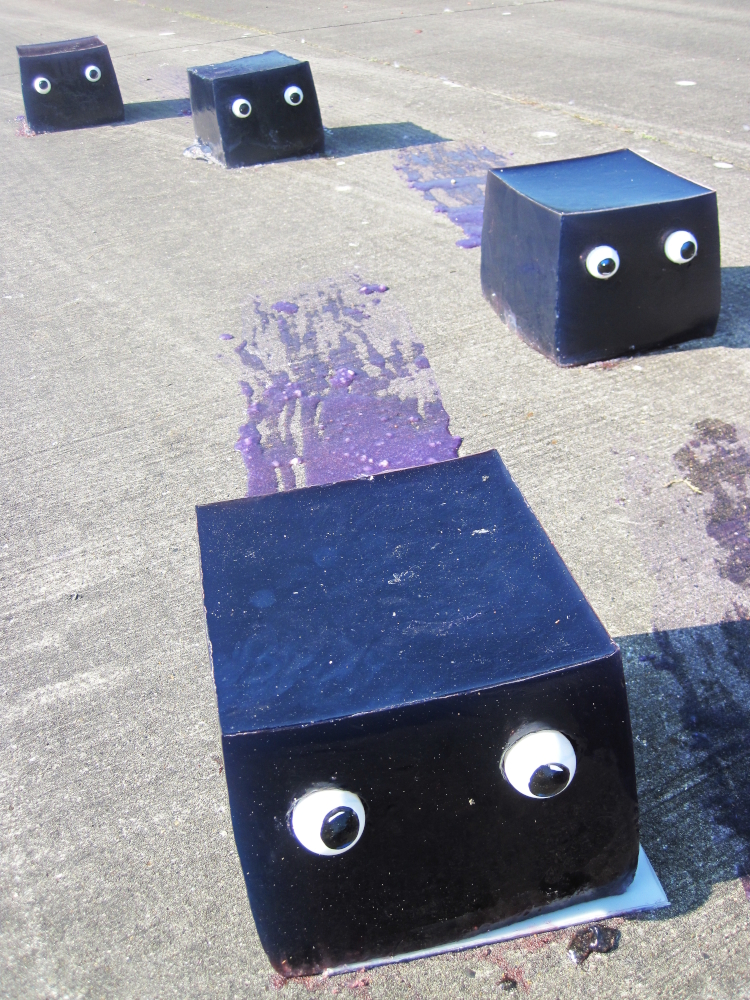
Jelly Monsters
Shaving Foam/ Shaving Cream
Widely available, and can be quite cheap, its other main
advantage is that it is very easy to wash off, probably the best messy
substance in this regard.
Some foams can cause a slight skin reaction to some people
so there is an advantage to those sold for people with sensitive skin if felt
necessary. If making 'custard pies' it is also best to allow it to stand for a
little while before use to allow evaporation of any excess propellant.
Standing the cans in hot water for 10 minutes before use
will improve the quantity of foam. If this is done, a typical 250ml can (in the
UK) will produce 3-4 litres of foam.
The nozzles on shaving foam cans will usually work in
filling balloons with a bit of care.
It is also possible to modify the nozzle to allow it spray a
distance. One method that I have done that works well is to swap the nozzle for
one from a spray paint can, and to carefully drill out the nozzle with a 1mm
drill bit. This will enable an effective spray of around 2m.
Whilst a little awkward to mix, it is possible to colour
shaving foam with food colouring.
Small quantities of water mixed in will make the foam more
pourable.
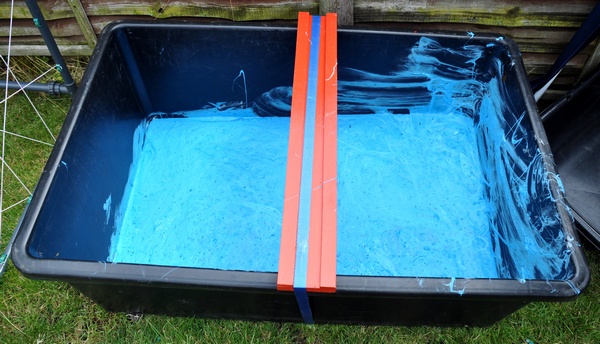
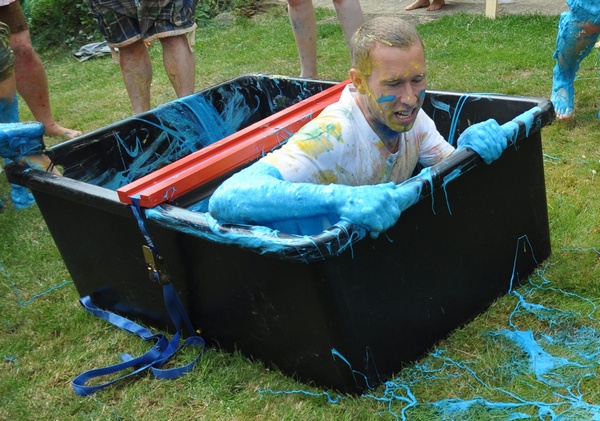
Oogoo- Fluffy Slime Made From Slime and Shaving Foam
Cream
An obvious example and key ingredient in many a slapstick
skit; effective and edible, its main downsides are how quickly some canned
whipped creams collapse; you may need to experiment to find a favourite. It is
also worth bearing in mind that in common with most dairy products they will
also quickly spoil if not refrigerated and leave lingering smells.
Savoury Sauces- Ketchup/ Mustard/ BBQ etc.
I recommend avoiding unless a specific need calls for them.
These can be acidic or astringent, so are best
avoided. Suitable substitutes
can usually be mixed up from gunge.
Sweet Sauces & Syrups-
Chocolate Syrup/ Nutella/ Ice Cream Topping/ Treacle etc.
Most sweet sauces will work very well and will likely be the
most widely accepted as a pleasant type of mess. Downsides are mainly cost, but
due to the level of sugar some (treacle particularly) can be very sticky and
hence difficult to wash off. It is also worth bearing mind they can attract
insects when used outside.
There are quite a range of types of syrups, but all have one
thing in common- they are primarily based on a sugar. The most common sugars encountered are Sucrose-
common table sugar, Fructose and Glucose. The syrup also contains water, and
usually a range of other components in much smaller quantities- these alter
flavour and colour primarily, but can include various vitamins and minerals
too.
Geographically the different types of syrup have different
availability- for instance corn syrup is uncommon in the Europe, and in the UK
we use molasses derived from sugar beet which differs in flavours to that
derived from sugar cane.
The rheology of all the syrups tends to be similar; they are
all approximately Newtonian which means they differ from most commercial
thickeners and therefore have a different visual effect.
Cake Decorating Ingredients- Icing/ Frosting/ Sprinkles/ Marshmallow Fluff etc.
Similarly to the sweet sauces these can work very well. Some
have a tendency to melt somewhat when hot as will occur if used on skin,
therefore if mixing from scratch the proportions need to be controlled for what
you intend to do with it. The cheapest option is to mix a basic water icing
with just icing sugar, water and any colouring you need but this can take time
for any significant quantity.
Marshmallow fluff/ marshmallow cream are a sticky, but
effective ready-mixed mess if budget isn't particularly important.
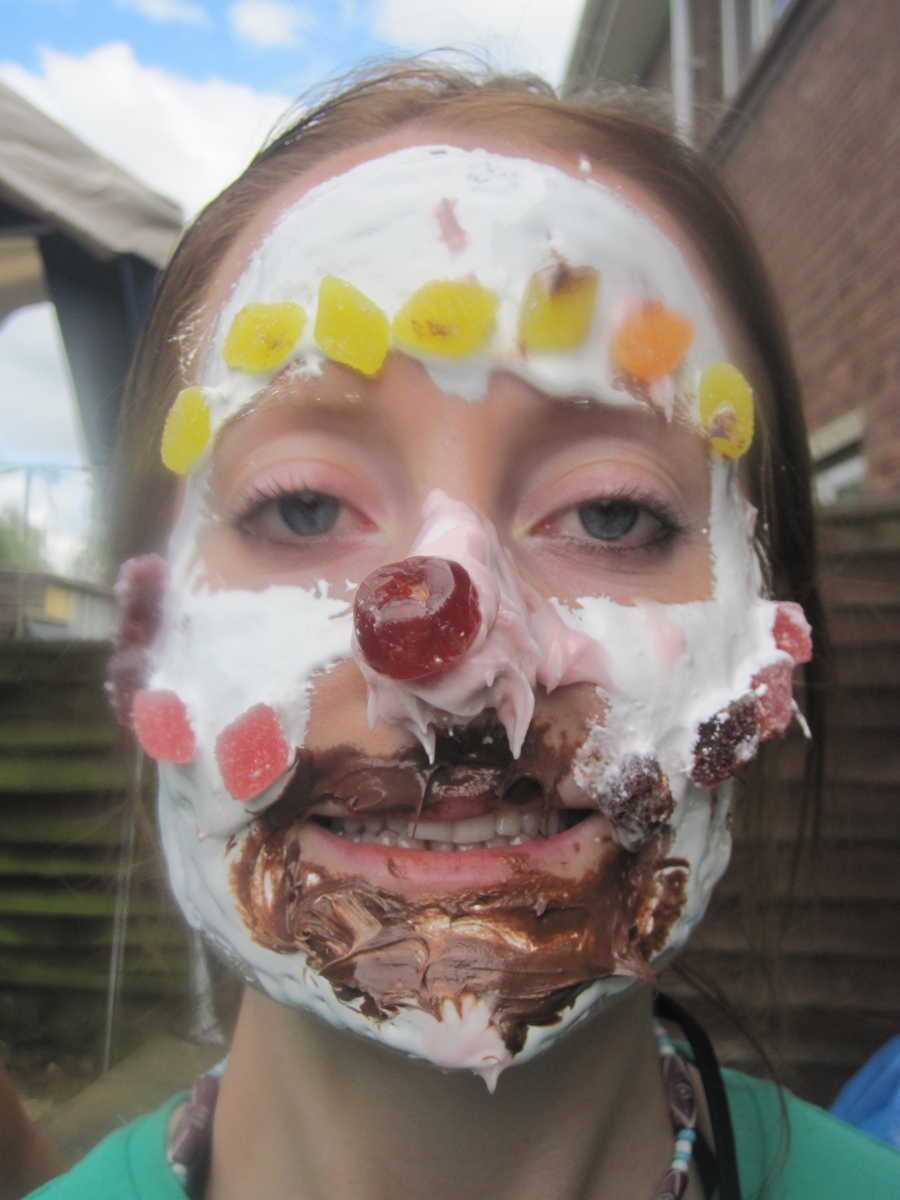
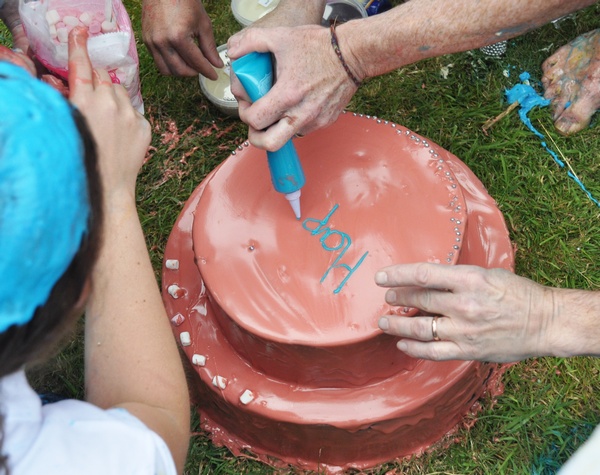 Cake Decorating Ingredients
Cake Decorating Ingredients
Mash
- Smash/ Instant Potato Mash
Instant mashed potatoes will hydrate fairly effectively if
mixed with cold water and allowed to stand, although using boiling water will
result in a higher viscosity for the same amount of water.
The texture of mash is quite different to many other types
of goo which may be an advantage.
Mash was beloved of Bodger and Badger- as "everybody
knows, badgers love mashed potato".
Cereals
-
Oats/ Weetabix/ Cornflakes etc.
Oats are one of my favourite alternative messy substances.
They are relatively cheap and widely available, and need little prep. They are
available in range of types, but at the very least need to be rolled which if
bought as porridge oats they inevitably will be. Preparation is simply by
mixing with water in a suitable quantity and allowing to stand (although you
can of course make porridge with hot water). If using cold wtities are 1 part oats to 2.5 parts water by mass, giving you approx. 3.5
parts by water volume, but this will depend slightly on the type used.
ater, you will need
to leave it to hydrate for at least 12 hours for the best goo. Typical
quan
Oats don't take food colouring well- you need an awful lot
to get a strong colour.
Oats can dry out very hard and be difficult to clean off as
anyone who has left a cereal bowl out will attest, so best to wash down whilst
still wet.
Oats in Use
Other cereals will hydrate in water to a range of different
types of mush. The texture of these can vary widely, which is an advantage and
they can lend this texture if mixed with other types of gunge. Like oats,
simply mixing with water and allowing to stand works well.
Custard Pies- Coolwhip, Dream Whip & Cream Substitutes
Coolwhip is an artificial substitute for whipped cream which
is widely used for 'custard' pies in the USA. It isn't readily available
elsewhere in the world, although similar products are. Dream Whip is an
equivalent available in the UK, although not in all supermarkets, and
commercial baking suppliers carry similar products that would be an appropriate
alternative. Key advantages over whipped cream are stability- they do not
readily collapse as real (or canned) whipped cream is apt to do. They will also
survive without refrigeration, and are therefore a good solution for 'custard
pies'.
Normally these cream substitutes are mixed with milk and
whisked, but they work equally effectively when made up with water, although
mixing can take a while and so a food processor is recommended.
 Dream Topping
Dream Topping
The base of a custard pie is an important part of the visual
effect, and so if this is important to you the best options are pre-made edible
pie or flan cases. These will however be somewhat fragile for handling and can
be relatively expensive, especially if many are needed.
Paper plates or aluminium pie tins are an obvious cheap base
alternative, but provide no padding underneath and have the potential to have
sharp edges, so care needs to be taken. For these reasons I prefer to use a
foam base- a circle cut from upholstery foam around 10" diameter and
1/2" or more thick. Some circuses use such a technique, but with more
sculpted shapes (A).
Other possible options are to use a meringue mix- some of
the commercial custard pie products sold as a powder are based on a dried
egg mix like this. It is also possible to buy commercial custard pie foam in a
can, manufactured by Smiffys which can be effective for small quantities,
but will get expensive for larger quantities. It is of course also possible to
use shaving foam as described above.
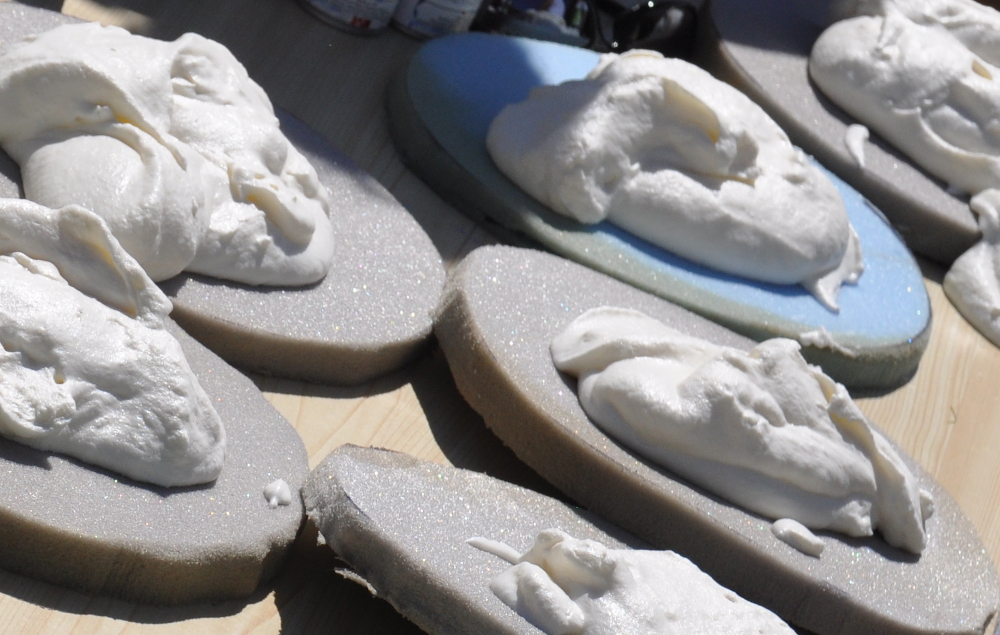
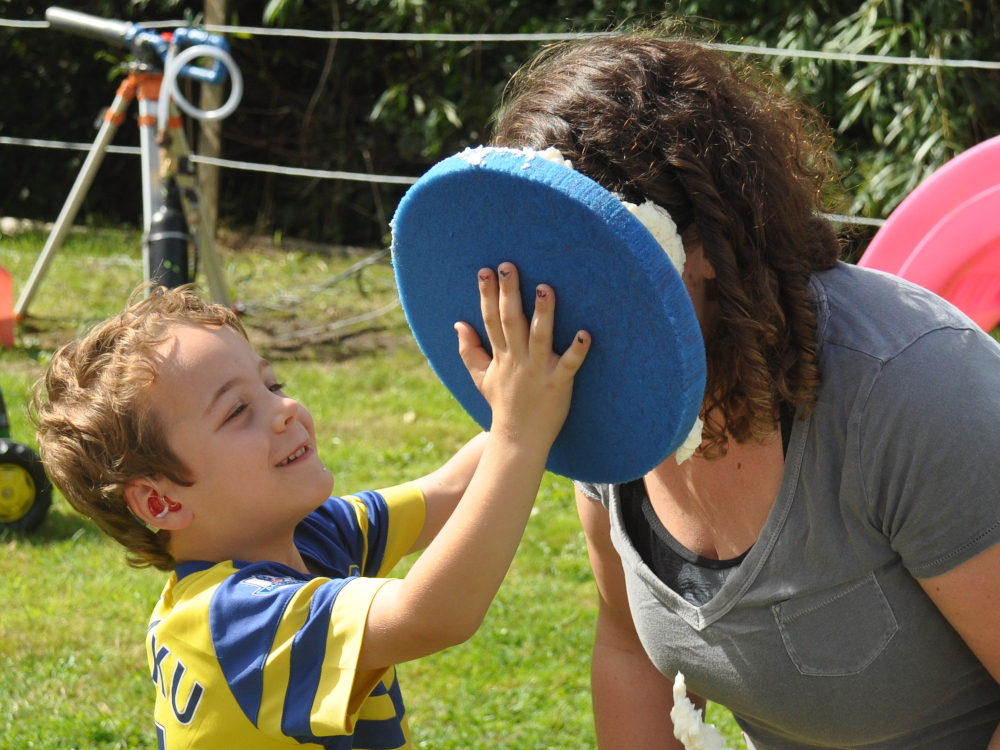 Custard Pies
Custard Pies
Flour/ Dough
Flour would at first glance appear to make a good messy
material, but when wet it becomes a good adhesive and becomes difficult to wash
out, particularly from hair. Having said that, in the right sort of environment
it can be a very effective mess.
There are many types of playdough recipe around, so at
present I am not going to publish any on this page. Those that contain cooking
oils however has less tendency to become sticky and are therefore easier to
wash out.
Cornflour/ Cornstarch/ Ooblek
Cornflour (UK) or Cornstarch (US) is a starch based flour
often used as a thickening agent in cooking in such items as stews, gravy etc,
and is the base ingredient in custard (pudding).
The powder is less 'sticky' than wheat flour and so is a
better option for activities that need a messy powder, and indeed forms the
basis of some of the colour/ Holi/ Gulal/ Throwing powders available (A). The
powder can be coloured by mixing a small amount of water with food colouring,
mixing with the powder and then drying- either in a low oven or in the sun.
When mixed with water, the cornflour has slightly unusual
properties- it is a 'non-Newtonian' fluid- one where how it flows depends on
the force applied to it. This means that when pushed hard or hit, it appears
almost solid, but can be allowed to flow like a liquid when released. It has
popularly become known as Ooblek after the Dr Seuss book 'Bartholemew and the
Ooblek'.
You may have seen one of the demonstrations on kids TV and
popular science programmes such as Blue Peter or Brainiac (B) of 'Walking on
Custard'- these are large scale demonstrations of the effect where it is
possible to walk on the mix as long as you keep moving.
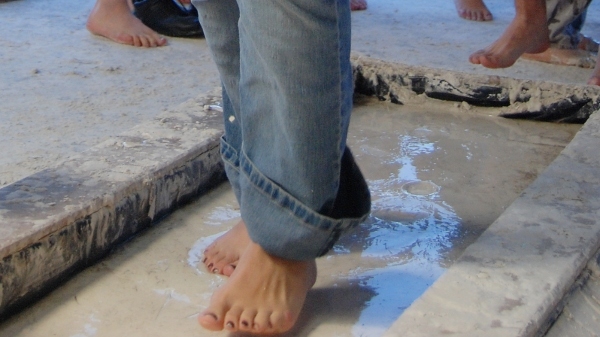 Walking on Custard
Walking on Custard
Custard/ Pudding
Custard (or pudding in the US) is a very effective messy material,
and is probably one of the easiest to use. It is available in readymade
cartons, and in flavoured versions (typically strawberry and chocolate). Clean
up is pretty easy.
You can make up from powder, and if you do this, water can
be substituted for milk in the recipe to make a cheaper version. You will need
to let the custard cool first, and as it does, it will thicken up further- you
will therefore need to take account of this when mixing otherwise it will potentially end up lumpy.
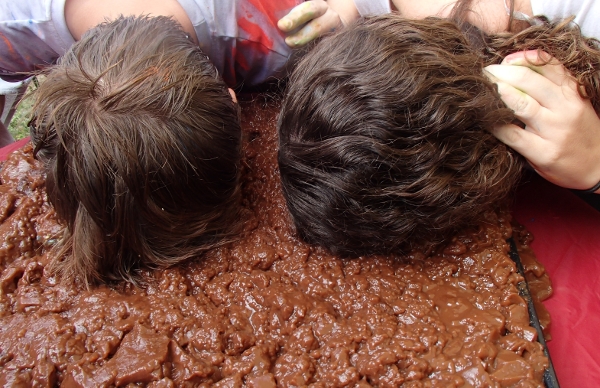 Chocolate Custard
Chocolate CustardCake Batter
Cake batter slime is very popular in the US as a simple
slime to make at home; take a packet and mix up with some added food colouring.
The additional ingredients over flour make it a simpler option to wash off, and
it is widely available in groceries. It is less commonly available in the UK
and elsewhere.
Cake batter slime is a favourite of many of the videos found
on YouTube due to it's simplicity
Paint
There are obviously many types of paint available that have
potential as messy supplies; however I would recommend that you restrict your
use to paints intended for kids use. Some of the ingredients in household and
other paints can be quite hazardous.
Powder Paint
When mixed with water, powder paints form a relatively low
viscosity of paint. They are cheap if bought in bulk and can be readily used to
colour water. They can be used dry as a powder- many of the colour run, Holi
celebrations etc. that have become common in the last couple of years use this
as a base. These paints have fallen out of popularity in recent years, and so
can be difficult to find on the high street but can still be bought from
educational suppliers.
Ready-mixed paint/ Tempera/ Poster Paint
There are a number of types of paint sold as ready mixed,
but most of them can be used in messy activities. If quantities larger than a
bottle full are needed, bulk packs (typically 5 litres) can be purchased from
educational suppliers. If even larger quantities are needed, as paint parties
are tending to use, then a thin gunge can be made with a higher degree of
powder paint than normal (8% is typical). This will give the visual effect of paint.
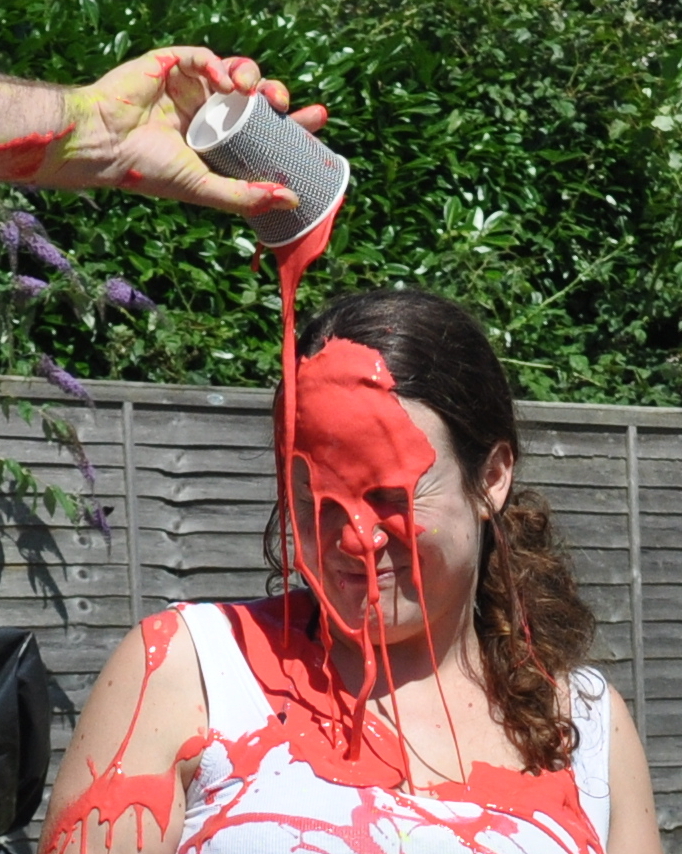 Powder Paint at 6%
Powder Paint at 6%
Mud & Clay (Soil & Dirt)
This deserves a whole page in its own right- keep your eyes
open for an update.
References
(A) https://www.clownantics.com/blogs/clownantics-blog/the-art-of-pie-throwing
(B) https://www.brainiac-tv.com/crazy-experiments/can-you-walk-on-custard/
(c) M Pantrey 2020-2024

